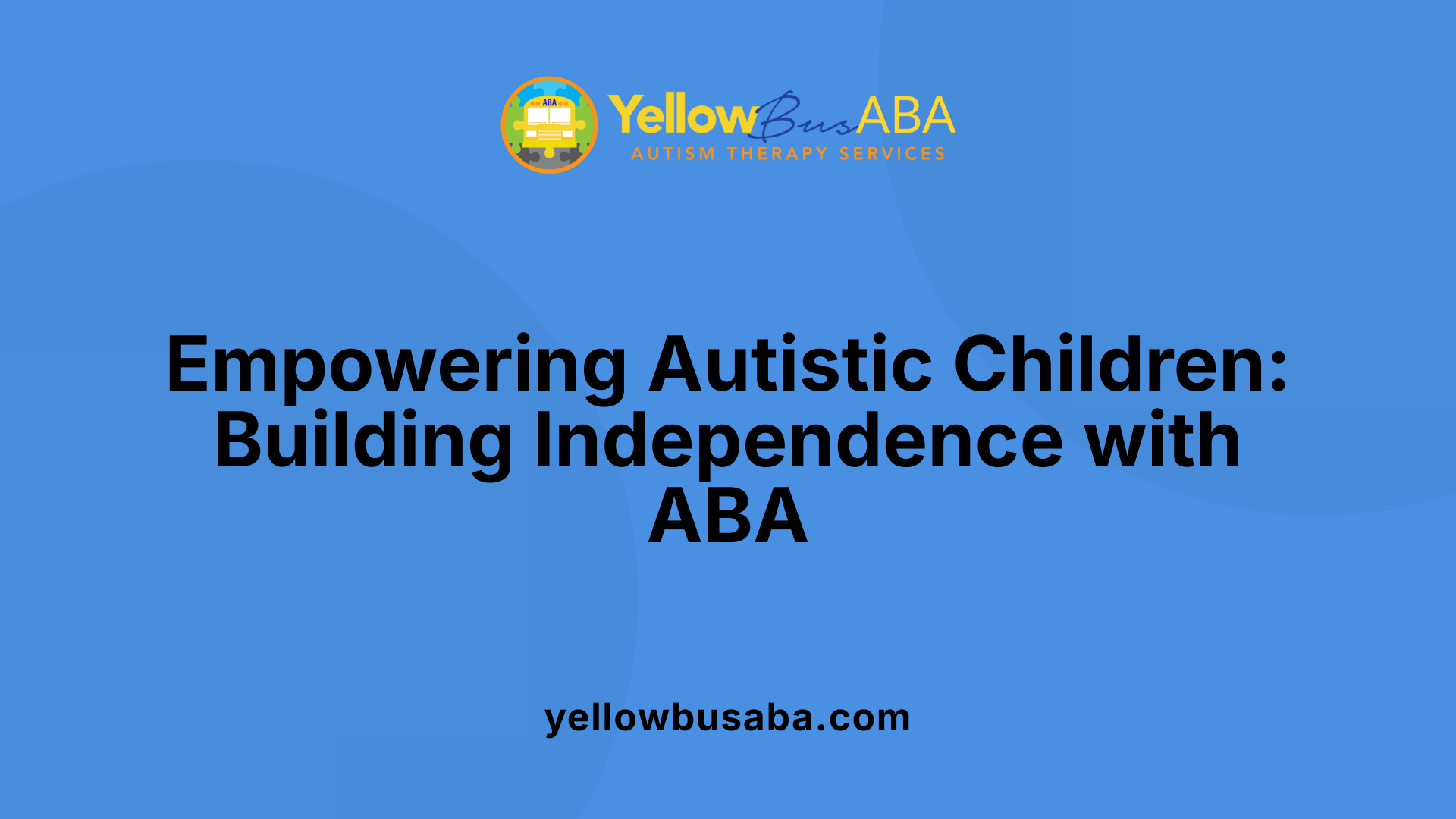Understanding the Journey to Independence for Children with Autism
Independence is a fundamental goal for every child, yet for children on the autism spectrum, the path to autonomy is uniquely complex and deeply personal. Modern therapeutic approaches, grounded in evidence and respect for neurodiversity, are reshaping how independence is understood and fostered. This article explores how therapies like Applied Behavior Analysis (ABA) and Positive Behaviour Support (PBS) help each child develop skills that honor their individuality while promoting meaningful growth and quality of life.
Applied Behavior Analysis (ABA): A Scientific Foundation for Skill Development

What is Applied Behavior Analysis (ABA) therapy and how is it used to support individuals with autism?
Applied Behavior Analysis (ABA) therapy is a scientifically validated approach designed to help individuals with autism spectrum disorder (ASD) develop important life skills and reduce challenging behaviors. It is based on the principles of learning and behavior, focusing on how behaviors are acquired and maintained through interactions with the environment.
ABA therapy supports individuals by creating highly individualized treatment plans tailored to their unique strengths, needs, and goals. These plans break down complex skills into small, manageable steps and use positive reinforcement to encourage desired behaviors. Through ongoing data collection and behavioral assessment, the therapy is constantly adjusted to maximize effectiveness.
How ABA supports individuals with autism
ABA targets socially significant behaviors such as communication, social interaction, academic abilities, and self-help skills. By teaching new skills systematically, including methods like picture exchange communication systems or sign language, ABA helps improve how individuals express themselves and relate to others.
The therapy also works to reduce behaviors that may be harmful or disruptive, such as tantrums or aggression, by identifying their triggers and applying strategies that provide safer alternatives. Importantly, skills learned are generalized across multiple settings and people, ensuring practical application in everyday life.
Families and caregivers play a vital role in applying ABA techniques outside of therapy sessions, fostering continuity and progress at home or in the community.
Key therapy techniques and their applications
ABA employs various techniques and evidence-based approaches, including:
- Positive Reinforcement: Rewarding helpful behaviors to increase their likelihood
- Discrete Trial Training (DTT): Breaking skills into step-by-step lessons repeated systematically
- Naturalistic Teaching: Using play or daily routines to teach skills in natural contexts
- Early Intensive Behavioral Intervention (EIBI): Intensive ABA tailored especially for young children under 5
Therapists may also incorporate augmentative communication devices and collaborate with speech, occupational, and psychological professionals to provide well-rounded support.
Starting ABA therapy early can lead to significant improvements in IQ, language, and daily living skills. However, interventions remain valuable throughout adolescence and adulthood, focusing on independence and coping strategies.
ABA therapy emphasizes a positive, respectful, and enjoyable experience that honors neurodiversity and avoids punitive methods. It continues to evolve through incorporating play, routines, and feedback from autistic individuals to maximize benefits and promote dignity.
| Aspect | Description | Application Details |
|---|---|---|
| Definition & Purpose | Scientifically based approach for skill-building and behavior change | Individualized plans to enhance communication, social, and life skills |
| Therapy Techniques | Positive reinforcement, DTT, naturalistic methods, EIBI | Applied systematically with progress data to adjust strategies |
| Support Focus | Develop independence, reduce harmful behaviors, generalize skills | Includes training for families and collaboration with other therapies |
| Target Population | Primarily children but adapted for adolescents and adults | Emphasizes early intervention but benefits across lifespan |
| Approach Philosophy | Positive, respectful, respects neurodiversity | Avoids punishment; focuses on enjoyment and dignity |
The Professionals Behind ABA Therapy: Expertise and Training

Who typically provides ABA therapy and what qualifications do these professionals need?
ABA therapy is generally delivered by specialized professionals with rigorous training and certification. The primary providers include Board Certified Behavior Analysts (BCBAs) and Registered Behavior Technicians (RBTs). BCBAs hold advanced degrees, often a master's or higher in psychology, education, or a related discipline. They design and supervise individualized treatment plans based on thorough behavioral assessments.
RBTs assist in the direct implementation of therapy under BCBA supervision, applying techniques like positive reinforcement and data collection to help the child meet specific goals.
Certification requirements and educational background
To become certified, BCBAs must complete intensive coursework aligned with the Behavior Analyst Certification Board (BACB) standards, including approximately 1,500 to 2,000 hours of supervised fieldwork. After this practical experience and academic training, candidates pass a stringent certification exam. RBTs also undergo specialized training and competency assessments to ensure proper execution of interventions.
Skills necessary for effective therapy delivery
Successful ABA therapists require a blend of technical and interpersonal skills. They must be proficient in behavioral data collection and analysis, enabling them to track progress accurately and adjust treatment plans accordingly. Strong communication skills are critical for collaborating with families and other professionals, while patience and adaptability help accommodate each individual's unique needs. Effective listening also ensures that therapy respects the child’s preferences and promotes a positive, engaging learning environment.
Together, these qualifications and skills empower ABA professionals to provide high-quality, individualized behavioral support, helping individuals with autism spectrum disorder achieve meaningful improvements in communication, social interaction, and daily living.
How ABA Therapy Empowers Children Towards Independence

What are the key benefits of ABA therapy for individuals on the autism spectrum?
ABA therapy offers numerous benefits for children with autism, including marked improvements in communication, social interaction, academic achievement, and essential daily living skills. By focusing on positive reinforcement and breaking complex tasks into manageable steps, ABA encourages the development of functional and adaptive behaviors while reducing challenging ones. Early intervention is particularly effective, often leading to significant gains in IQ, language, and independence, which further enhances quality of life and social participation.
Which skill areas does ABA target?
ABA therapy targets a broad range of socially significant skill areas tailored to each child's needs:
- Communication: Teaching the use of speech, sign language, picture exchange systems, or augmentative devices to improve expressive and receptive communication.
- Social Skills: Enhancing interaction abilities such as sharing, turn-taking, and understanding social cues.
- Academic Skills: Building foundational concepts and academic readiness.
- Self-help Skills: Developing independence in activities like dressing, eating, and hygiene.
- Behavioral Skills: Reducing behaviors such as tantrums or aggression by identifying and addressing their triggers.
How does ABA impact communication, social interaction, and daily living?
ABA therapy systematically teaches and reinforces communication and social skills through individualized plans and consistent positive reinforcement. This approach helps children engage more effectively with family, peers, and educators, fostering meaningful relationships. Additionally, ABA promotes daily living skills that enable children to perform self-care routines and participate in community life more independently. The continual data-driven adjustment of strategies ensures skills generalize across settings and people, making them practical and long-lasting.
| Aspect | ABA Approach | Outcome |
|---|---|---|
| Communication | Use of speech training, sign language, augmentative devices | Improved expressive and receptive abilities |
| Social Interaction | Structured social skills teaching with natural reinforcement | Enhanced peer engagement and social understanding |
| Daily Living Skills | Step-by-step teaching of self-help tasks | Greater independence and quality of life |
| Behavior Management | Identification and reduction of problematic behaviors | Safer behaviors and reduced distress |
ABA Therapy in Practice: Techniques and Session Structure

Assessment and Individualized Planning
ABA therapy begins with a thorough assessment conducted by a Board Certified Behavior Analyst (BCBA). This behavioral assessment identifies each child's strengths, needs, and behaviors that require modification. Based on these findings, therapists develop individualized treatment plans tailored to the child's unique profile. This customized approach ensures that therapy goals focus on socially significant skills like communication, self-help, academic abilities, and social interaction.
Techniques Such as Discrete Trial Training and Natural Environment Teaching
ABA therapy employs structured techniques including Discrete Trial Training (DTT), where specific skills are taught in small, repeated steps with clear prompts and positive reinforcement. Alongside, Natural Environment Teaching (NET) integrates learning opportunities into daily routines and natural settings, promoting generalization of skills across environments. Techniques like behavior chaining and prompt fading support the development of complex behaviors gradually and effectively.
Role of Data Collection and Progress Monitoring
Central to ABA therapy is its data-driven approach. Therapists continuously collect data during sessions to track responses and behavior changes. This ongoing monitoring allows for adjustments in intervention strategies based on measurable progress, ensuring therapy remains effective and goals are aligned with the child’s evolving needs.
Parental Involvement and Home Support
Parents and caregivers are essential partners in ABA therapy. Training helps them implement ABA techniques consistently at home and other environments, reinforcing learning and fostering independence. This collaboration extends the benefits of therapy beyond clinical sessions, promoting continuous growth and enhancing the child’s quality of life.
| Aspect | Description | Benefits |
|---|---|---|
| Assessment | Conducted by BCBAs to tailor individualized plans | Targets relevant skill areas and behaviors |
| Discrete Trial Training | Teaches skills through repeated, structured trials with reinforcement | Builds specific skills efficiently |
| Natural Environment Teaching | Uses natural settings to generalize skills | Encourages real-world application of learning |
| Data Collection | Continuous tracking of behaviors and progress | Enables timely adjustments to improve effectiveness |
| Parental Involvement | Training and support for caregivers to reinforce therapy | Extends learning beyond sessions, supports consistency |
Emphasizing Respect and Autonomy: Positive Behaviour Support (PBS)

What is Person-Centred Support in Autism?
Person-centred support focuses on understanding and addressing the unique needs of autistic individuals. It involves collaboration with the person and their support network to create tailored plans that consider individual preferences, environmental factors, and triggers for distress. This approach values dignity and respects the individual's preferences and autonomy.
What Principles Does PBS Emphasize?
Positive Behaviour Support (PBS) emphasizes promoting joy, independence, and a high quality of life. It steers clear of punishment or attempts to alter core autistic traits, instead fostering respect and understanding. PBS supports developing personalized strategies, such as structured routines to minimize anxiety during unstructured times, helping autistic individuals thrive in ways that honor their identity.
How Does PBS Complement ABA and Other Therapies?
PBS works alongside therapies like ABA, speech, occupational therapy, and psychological support. While ABA focuses on teaching skills and modifying behaviors through positive reinforcement, PBS prioritizes understanding reasons behind behaviors and environmental influences, ensuring support is humane and aligned with the individual's needs. Together, these approaches provide comprehensive, compassionate assistance.
Why Avoid Punitive Methods and Embrace Neurodiversity?
PBS explicitly discourages punitive or aversive methods, promoting positive, respectful interventions instead. Embracing neurodiversity means recognizing and valuing the differences of autistic individuals rather than trying to 'normalize' them. This approach supports autonomy, reduces anxiety, and fosters environments where autistic people can live with dignity and respect.
Navigating Criticism and Evolving Practices in Autism Therapy

Are there any criticisms or controversies associated with ABA therapy?
Applied Behavior Analysis (ABA) therapy, while widely recognized as an evidence-based intervention for autism, has faced criticism regarding its traditional methods. Some critics argue that ABA's earlier approaches were often rigid and emphasized compliance, sometimes at the expense of understanding the individual's unique perspective. This could lead to repetitive or intrusive interventions aimed mainly at eliminating behaviors that did not fit neurotypical norms. Such practices risk suppressing the individual's authentic ways of being.
In response, ABA has evolved considerably. Modern methodologies focus on respectful, individualized approaches that honor neurodiversity and prioritize the individual's autonomy and joy. Instead of using punitive measures, current ABA practices emphasize positive reinforcement, naturalistic teaching, and play-based techniques. This evolution reflects a broader shift in autism therapy toward interventions that are not only effective but also socially valid and aligned with the preferences and dignity of autistic individuals.
Shifts towards respectful, individualized approaches
The field now increasingly values person-centered strategies, ensuring that therapy is tailored to each individual's specific strengths, needs, and desires. The engagement of clients and their families in planning and decision-making recognizes the importance of social validity — the meaningfulness and acceptability of interventions to those receiving them. Modern ABA integrates client input to foster independence and quality of life rather than enforcing normalization.
Importance of social validity and client preference
Social validity involves evaluating how well therapy goals, procedures, and outcomes are accepted by clients and their support networks. ABA practitioners aim to incorporate preferences, ensuring interventions feel supportive rather than restrictive. This sustained emphasis on collaboration helps cultivate environments where autistic individuals can thrive comfortably and confidently.
Integration of neurodiversity and play-based methods
Contemporary ABA approaches respect and celebrate neurodiversity by incorporating play, routines, and natural settings into therapy. Play-based methods not only make learning enjoyable but also enhance generalization of skills across environments. These strategies foster joy, creativity, and self-expression, moving away from outdated punitive models. The integration of these elements reflects an ongoing commitment within the ABA community to ethical practice and holistic support.
By acknowledging critiques and embracing evolving methods, ABA therapy continues to adapt in ways that empower autistic individuals, emphasizing respect, autonomy, and well-being.
Redefining Independence: Embracing Individual Potential and Support
Independence for children with autism is not a one-size-fits-all destination but a nuanced journey shaped by each child's unique profile, preferences, and aspirations. Through personalized therapies like ABA and PBS, which emphasize respect, dignity, and joy, children are equipped with the skills and confidence to navigate their worlds on their own terms. As therapy practices continue to evolve—integrating neurodiversity, play, and family involvement—the future promises more compassionate, effective support that honors individuality and promotes authentic independence across all stages of life.
References
- How does ABA therapy help children with autism?
- Positive Behaviour Support (PBS)
- Questions and answers about ABA
- Is ABA Therapy Effective for Autism?
- How to Become an ABA Therapist - School of Education
- How to Become an Applied Behavior Analyst (ABA) Therapist
- Board Certified Behavior Analysts (BCBA)
- The Controversy Around ABA
- Concerns About ABA-Based Intervention: An Evaluation and ...



.jpg)

.avif)
